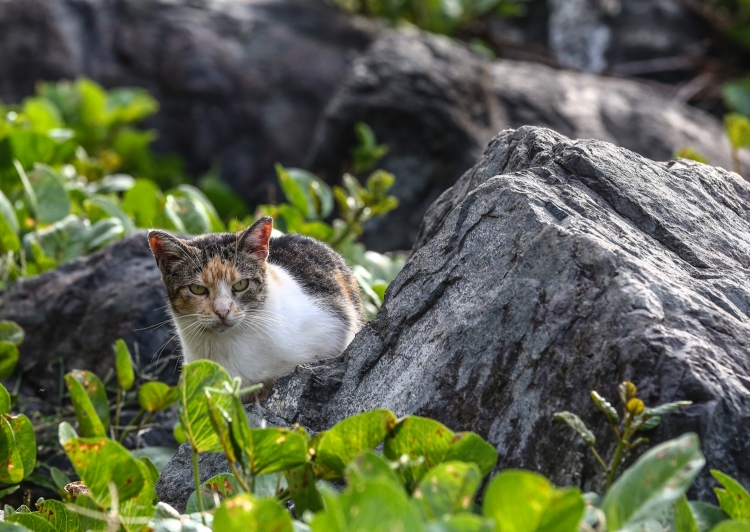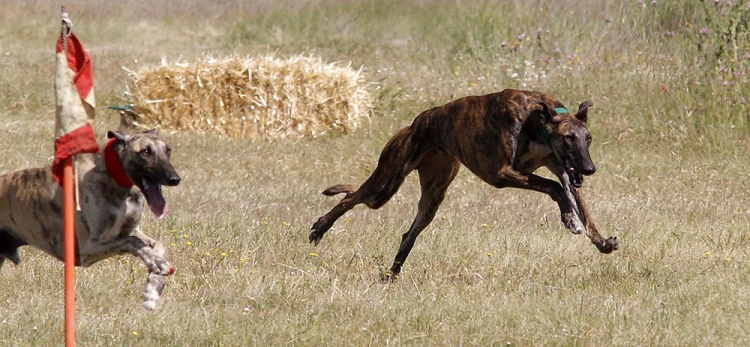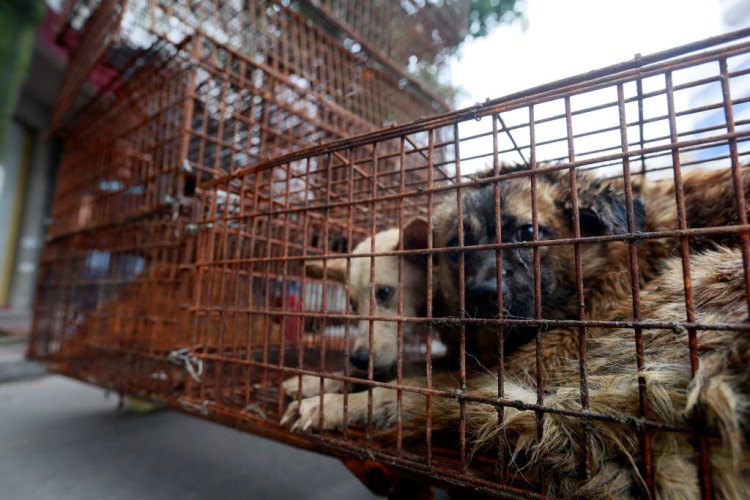Once upon a time in the 1950s, some rats decided to take up residence in the colorful colonial town of Old San Juan, Puerto Rico. After all, who wouldn’t love to live in such a charming little city by the sea? But the humans who lived there weren’t too happy about their pesky rodent neighbors, whose numbers were increasing rapidly. So they came up with a brilliant idea – bring in some cats. And within a short period of time, their rat problem was solved. The humans were very grateful to the cats, who were allowed to stay in Old San Juan and coexist with them in harmony. That is, until the feline population began to get out of control.
While some good-intentioned people in the community had taken it upon themselves to feed the cats, this did nothing to stop the felines from multiplying. Now there were hundreds of stray cats prowling the streets, getting into garbage and using the city as a giant litter box. Some of them were sick and injured, not a pretty sight for locals or tourists. The city realized it had a veritable “cat-pocalypse” on its hands.
By 2004, one of the biggest hotbeds of the stray cat problem was centered at the Paseo del Morro National Recreation Trail, a waterfront walkway that winds alongside the San Juan Bay and the western section of the San Juan Wall. Approximately 250 feral cats were living along the Paseo, which had recently been refurbished as a public walking and jogging path. But when park service officials proposed “getting rid” of the “problem” by trapping and removing the cats, the animal lovers of Old San Juan would hear nothing of it. Fearing the cats would be euthanized, they started a letter-writing and petition campaign that ended up being signed by thousands of outraged citizens.

One of the feral cats living along the Paseo del Morro. Some of the felines that prowl around Old San Juan are believed to be descendants of cats that arrived on the ships of the first Spanish settlers when they came to Puerto Rico in the 17th century.
And that’s when three brave ladies decided to come forward and take it upon themselves to save the cats. They asked the National Park Service to give them six months to spay and neuter all of the feral felines along the Paseo, humanely euthanize the sickest animals, and find homes for the adoptable kitties. Happy to have the cat crisis off their hands, the powers that be agreed and Save A Gato was born.
Twelve years later, Save A Gato is a well-established, all-volunteer organization dedicated to helping the street cats of Old San Juan and responsible for managing the Paseo’s feral cat colony. Through humane TNR (Trap-Neuter-Return) methods, the organization has decreased the colony’s population from 250 felines in 2005 to around 100. Ferals receive regular food, water, medical care and shelter for the rest of their lives, while kittens and friendly cats get a chance to find forever homes throughout Puerto Rico and in the mainland U.S. via Save A Gato’s adoption program.
While not everyone who lives in OSJ professes to be a cat-lover, some locals acknowledge that along with the narrow cobblestone streets, pastel-colored residences and 17th-century fortresses overlooking the ocean, the cats have become part of “The Old San Juan Experience” that tourists enjoy. And even kitty naysayers know that the cats play a crucial role in keeping down the rodent population and thus, preventing disease. Since 15 percent of the buildings in OSJ are abandoned, without the cats the rats would once again proliferate.

Another Paseo feral, this one giving us the evil eye for disturbing his breakfast. Note the tip of his ear has been removed to mark his sterile status. Photo credit: Chris Savas
When I happened to hear about Save A Gato while visiting Puerto Rico last month with my husband, I knew I had to meet this amazing group. We had just spent the day with The Sato Project and I was fired up to meet more inspiring people on the island who were going above and beyond for the welfare of animals. So on our second-to-last day in Old San Juan, Chris and I rose with the sun, got some coffee and walked to the Paseo, thinking we’d check out the feral colony first and take a few photos before heading to the group’s headquarters in the nearby park.
Once on the walkway, it didn’t take long to catch sight of the cats, many of them prowling in the bushes or sunning themselves on the rocks along the water. Some were still enjoying breakfast at one of several feeding stations Save A Gato maintains on the trail and barely acknowledged our presence, while a few of the more sociable kitties seemed to take an interest and began following us. Minutes later we seemed to have attracted a rainbow of cats – calicos, tortoise shells, tigers, marmalades, black and whites, grays, gingers and solid blacks. Most appeared healthy, contented and well fed.

Myriam Pabon and Irma Podesta, two very dedicated, kind-hearted women who help make Save A Gato possible. Photo credit: Chris Savas
After a 30-minute photo session with the photogenic ferals, we retraced our steps out of the Paseo and up into the park, where Save A Gato maintains a tiny, one-room building called a Casita. This is where 12 of the group’s 20 volunteers take turns caring for adoptable cats and kittens as well as sick or injured cats. Upon arriving at the tiny, bright pink shack, we were immediately greeted by Myriam Pabon, volunteer coordinator and casita director, and Irma Podesta, Save A Gato’s lead rescuer, trapper and social media coordinator. Both have been volunteering with the organization for over a decade.
As we sat down and Myriam began telling us about Save A Gato and how it started, we found ourselves swarmed by a few of the 70 friendly kitties that live around the Casita – all in that same amazing kaleidoscope of coat colors – rubbing up against us, climbing in our laps and mewing for attention. Most are highly adoptable but simply haven’t been able to find the right homes. Chris is terribly allergic to cats but maintained a brave face as he was surrounded by attention-seeking felines. One even climbed into his lap and stared up into his face as if to say, “hey, why aren’t you petting me?”

Just a few of the 70 cats Save A Gato cares for at the Casita. “Gato” is the Spanish word for cat. Photo credit: Chris Savas
As Myriam continued her story, it became evident that while Save A Gato has made huge strides in OSJ over the past 12 years, the organization is facing its fair share of daunting challenges lately, thanks in part to a bad economy and people abandoning their pets in droves.
“Over 60 percent of the population in Puerto Rico is living in poverty, so if people don’t have money for themselves, their children and their needs, forget about the animals,” Myriam explained. “Because we’re having hard economic times, a lot of people are losing their homes and leaving their animals behind. Even people with money don’t want to spend anything on a cat.”
She continued, “But even people who can’t take care of their pets don’t want to take them to a shelter where they will die. Our problem is we want to decrease the cat population but people are coming from all around the island just to leave their cats here. It’s endless because we have to give priority to the community of Old San Juan and we have so many animals here that aren’t neutered, and we neuter almost weekly.”

Newbie volunteer Marie Sela cleans out one of the kitten cages in the Casita. Did you know that just one unaltered female cat and her offspring can produce 370,000 cats in just seven years? Photo credit: Chris Savas
Luckily, relief may soon be coming for Save A Gato and the island’s other incredible animal rescue organizations thanks to the Humane Society of the United States, which launched an aggressive animal welfare campaign in Puerto Rico last year. Part of its many progressive initiatives include establishing island-wide high-volume spay and neuter services, providing humane education for all public elementary school students, and working with local governments to crack down on irresponsible pet owners and enforce Puerto Rico’s Animal Protection and Welfare Act 154.
But until that happens, Save A Gato will be working overtime to garner enough support so it can continue its lifesaving mission – helping OSJ’s street cats for the foreseeable future.
“Twelve years ago people didn’t understand spay and neuter, about keeping cats healthy, how to care for them or how to control the population,” said Irma. “Today the metropolitan area is more aware of this, but on the rest of the island people still have no idea of what to do and we don’t have enough programs to help them. People think that if a female cat has 15 kittens, just throw them in the street and let them starve to death. So we really need more funding, more volunteers, more adoptions and the ability to send more cats to the U.S. With enough money we could fix every cat in Old San Juan.”

This handsome guy is simply waiting for the right home. Could you be his perfect forever human? Photo credit: Chris Savas
Want to help the stray and abandoned cats of Old San Juan? Here’s what you can do:
- Give money: Save A Gato is in great need of funds to pay for cat food, supplies, veterinary care and spay and neuter surgeries. No amount is too small and every penny goes to helping the cats. To make a donation, go here.
- Donate supplies: Save A Gato can always use dry and wet cat food, cleaning products, flea preventative, towels, cages, cat toys and bowls. If you live in Puerto Rico or are visiting soon, please contact the organization to set up a time to drop off your donation.
- Volunteer: Even if you don’t live in Puerto Rico, you can still become a Save A Gato volunteer. Go here to check out all the great ways you can help make a difference!
- Adopt: Save A Gato usually has about 40 kittens or young cats available for adoption at any given time. If you’re interested in adopting one of their adorable kitties, please reach out to them on their Facebook page or website to set up a time to meet the kittens and take one (or more) home.

One of my favorite photos I took at the Paseo – a little mustacheoed feral watching us from afar. Whether he was an abandoned pet or born on the streets, we’ll never know. Either way, he seemed content to keep his distance.
Here are some other wonderful animal rescues and shelters in Puerto Rico in need of help and support:
Santuario de Animales San Francisco de Asis
Vieques Humane Society and Animal Rescue
“Life is life, whether in a cat, or dog or man. There is no difference there between a cat or a man. The idea of difference is a human conception for man’s own advantage.” – Sri Aurobindo






































































